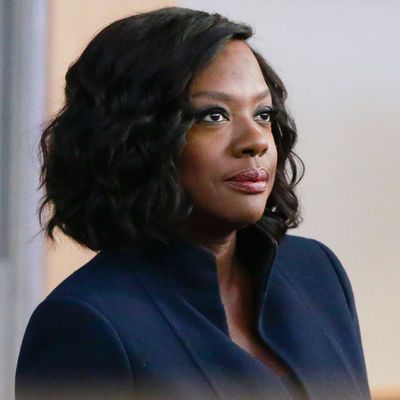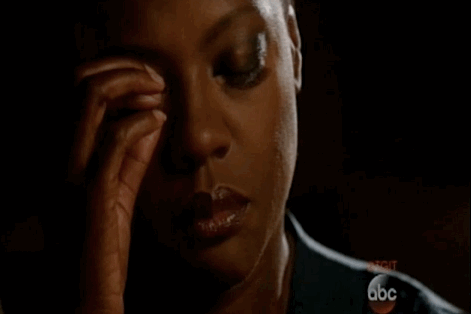
Let me just start by stating that THIS IS THE SINGLE GREATEST MOMENT IN BLACK WOMEN TELEVISION HISTORY. Sorry, I don’t mean to go caps lock on ya like that, but I really feel it is the only way to emphasize how important this moment was. Let me set the scene, and then you’ll see why I’m not exaggerating. BTdubs, what I’m about to tell you is a major spoiler, so if you haven’t seen season one of How to Get Away With Murder, read this at your own peril.
To set the scene: Annalise Keating (Viola Davis) is a high‑powered lawyer with dubious morals, who has been married to her husband, Sam, for a long time. They’re both cheating on each other, which isn’t as trifling as it sounds. I mean, two people cheating on each other is like when you and a bestie both have New Year’s resolutions to find better jobs and then on January 2, it all goes to shit because you both independently discover that there’s a Judge Joe Brown marathon on TV and decide it’s way more fun to watch that than it is to upload résumés to Monster.com. Then when you find out the other messed up, instead of getting mad, you just giggle and share a look like, “No one will ever get me the way that you do.” What I’m getting at here is that Annalise and Sam both messed up, so it cancels out. That’s how relationships work, right?

Anyway, while Sam was fooling around with a college student, Anna was hooking up with a superhot black cop who would show up to her job and go down on her, a.k.a. the man was a true American hero and every time he showed up onscreen, I pledged my allegiance to him like he was the damn United States flag. These side relationships were going swimmingly until Sam knocked up his jump off and then, under mysterious circumstances, she was killed. Sam denied any wrongdoing, but when faced with incriminating evidence that would ruin his life, Annalise decides to call him out.
Here’s a lesson to all of us: If you are going to confront your cheating husband with the greatest nine‑word question in television history — “Why is your penis in a dead girl’s phone?” — you want to have your wig off when you say it. Because no matter what his answer is going to be, it’s only going to piss you off and make you want to fight, and you can’t fight if you’re too worried about your wig getting snatched like a white teenage girl in a Lifetime movie. So you must take the wig off and carefully hang it somewhere the way Jews delicately hang a mezuzah outside their homes to protect those inside it. And that’s exactly what Annalise did right before talking to Sam.
That’s right! And not only did she take off her wig and makeup, they then showed her putting on cocoa butter before the interaction. Damn! If the show’s producers had shown her in the kitchen turning on the stovetop to medium heat and putting a hot comb through the hair of some neighborhood children, I would have fainted. It’s not an overstatement when I write that watching a part of the black woman’s beauty routine reflected back at me made me praise dance the way I do when I’m in the Pillsbury crescent‑roll section of my grocery store. This scene was so real, so honest, so raw, so everything because this is what a lot of black women look like when not in public. To present that to America was huge. Not only did it show what beauty preparation is like for many black women, it let most, if not all, non-black people into a world that had previously been off‑limits to them. Usually, the media has shown black women as resilient and unbelievably strong in the face of crisis, so for a show to reveal a BW’s vulnerability is monumental. This scene, and in particular the wig removal, illustrated that black women do have emotions, do get hurt, and do express themselves. To have this happen on an extremely popular nighttime show on ABC was incredible. It made me die, go to heaven, say “wait a minute,” and come back down to Earth the way you come back to your house when you realize you left the bathroom light on, because I needed to be alive to see how else Viola Davis is going to recontextualize black women for the rest of the world. And that, ladies and gents, is why Viola Davis’s wig removal on How to Get Away With Murder is THE SINGLE GREATEST MOMENT IN BLACK WOMEN TELEVISION HISTORY.
From YOU CAN’T TOUCH MY HAIR: And Other Things I Still Have to Explain by Phoebe Robinson, to be published on October 4 by Plume, an imprint of Penguin Publishing Group, a division of Penguin Random House LLC. Copyright (c) 2016 by Phoebe Robinson.




